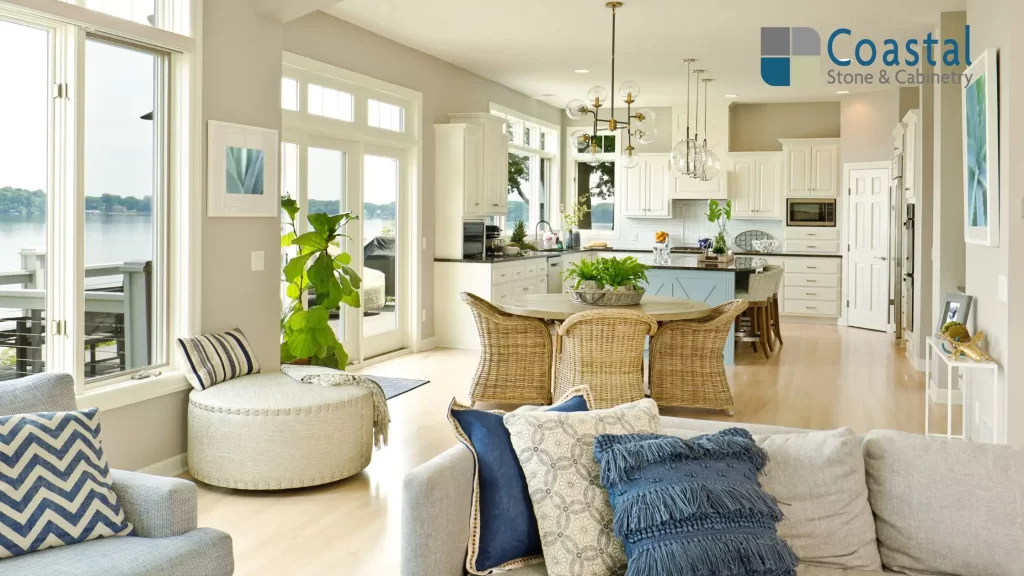Open-concept kitchens have become a popular design trend, offering a spacious, modern feel that promotes interaction and flow throughout the home. Whether you’re remodeling an existing kitchen or planning a new build, achieving a seamless look in your open-concept kitchen design requires thoughtful planning and attention to detail. Here are some essential tips and tricks to help you create a stunning and cohesive open kitchen space.
1. Define Zones Without Walls
One of the key challenges in an open-concept kitchen is maintaining defined areas for cooking, dining and living without the use of walls. Use furniture and design elements to create distinct zones:
- Islands and Peninsulas: Incorporate an island or peninsula to separate the kitchen from the living or dining area. This not only provides additional counter space but also helps delineate the kitchen area.
- Area Rugs: Place area rugs under the dining table or seating area to visually separate these spaces from the kitchen.
- Ceiling Treatments: Use different ceiling treatments, such as beams or a dropped ceiling, to define specific areas within the open space.
2. Consistent Flooring
Using the same flooring material throughout the open-concept space is crucial for a seamless look. Whether you choose hardwood, tile or another material, extending it across the kitchen, dining and living areas will create a cohesive flow and make the space feel larger. Explore our flooring options to find the perfect match for your home.
3. Harmonize Color Schemes
Consistency in color schemes is essential to achieving a seamless design. Select a palette that compliments the entire open space and use it across all areas. Here are some tips:
- Neutral Base: Start with a neutral base for walls and large furniture pieces to create a unified look.
- Accent Colors: Use accent colors sparingly to add interest and personality without overwhelming the space. Choose shades that complement each other and appear in multiple areas, such as cushions, artwork and accessories.
- Cabinetry and Furniture: Ensure that the cabinetry, countertops and furniture harmonize with the overall color scheme. Consistency in materials and finishes will tie the spaces together.
4. Seamless Storage Solutions
An open-concept kitchen design requires smart storage solutions to keep the space looking clean and organized. Consider the following strategies:
- Integrated Appliances: Choose appliances that blend seamlessly with cabinetry to maintain a cohesive look. Built-in ovens, hidden refrigerators and integrated dishwashers are excellent options.
- Open Shelving: Use open shelving to display attractive kitchenware and decorative items, adding visual interest without disrupting the flow of the space.
- Efficient Cabinetry: Opt for cabinetry that maximizes storage while maintaining a sleek appearance. Pull-out drawers, Lazy Susans and custom organizers can keep clutter out of sight.
5. Strategic Lighting
Proper lighting is crucial in an open-concept kitchen to create a balanced and inviting atmosphere. Layer different types of lighting to achieve the best results:
- Ambient Lighting: Provide overall illumination with ceiling lights or recessed lighting throughout the space.
- Task Lighting: Install task lighting, such as under-cabinet lights or pendant lights over the island, to ensure adequate light for cooking and food preparation.
- Accent Lighting: Use accent lighting to highlight architectural features, artwork or decorative elements, adding depth and interest to the space.
6. Consider Sight Lines
Open-concept kitchens are designed to be visually connected to other living areas, so it’s important to consider sight lines when planning your layout. Ensure that the kitchen is attractive from all angles by:
- Hiding Clutter: Keep countertops and open shelves tidy to maintain a clean and appealing look.
- Highlighting Features: Design focal points, such as a beautiful backsplash, a statement island or stylish lighting fixtures, that draw the eye and add visual interest.
- Avoiding Obstructions: Arrange furniture and cabinetry to avoid blocking sight lines, creating a smooth visual flow throughout the space.
7. Blend Indoor and Outdoor Spaces
If your open-concept kitchen connects to an outdoor area, blur the boundaries between indoor and outdoor living for a seamless transition:
- Large Windows and Doors: Use large windows or sliding glass doors to create a connection between the kitchen and outdoor spaces, allowing natural light to flood in and enhancing the sense of openness.
- Consistent Materials: Extend indoor materials, such as flooring and countertops, to outdoor areas for a cohesive look.
- Outdoor Kitchen: If space allows, consider adding an outdoor kitchen or dining area that complements your indoor design.
By implementing these design tips, you can create a seamless and stylish open-concept kitchen that enhances both the functionality and aesthetics of your home. Whether you’re entertaining guests or enjoying a quiet family meal, a well-designed open kitchen will provide a beautiful and inviting space for all your needs.
For more inspiration and to see some of our completed projects, visit our gallery or contact us for a free consultation.




